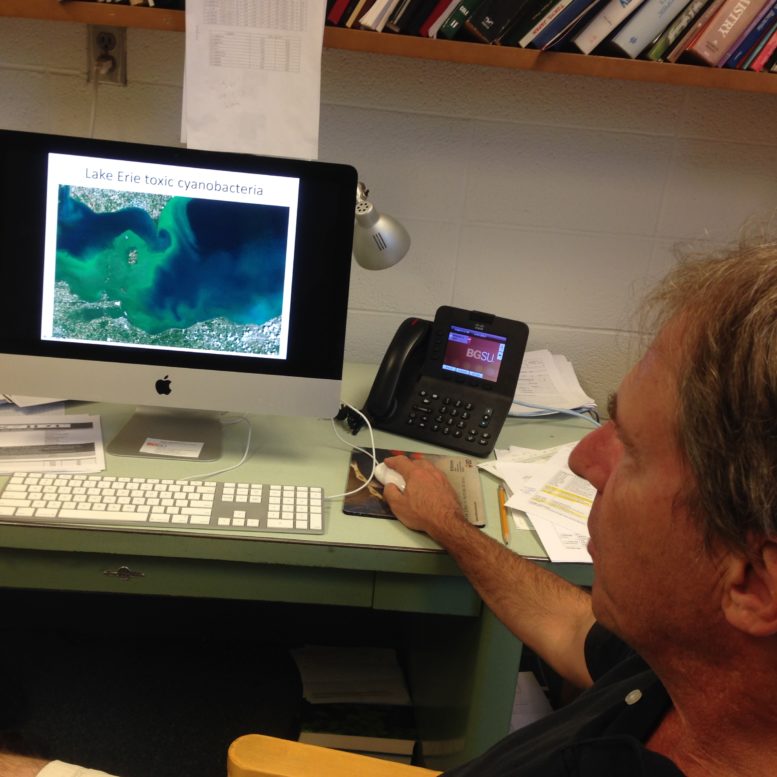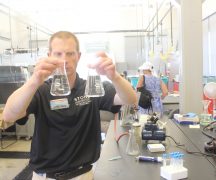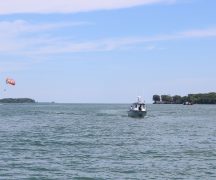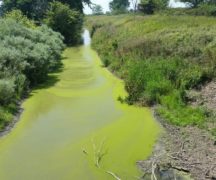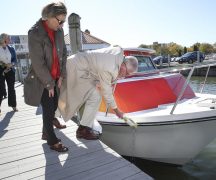By DAVID DUPONT
BG Independent News
Dry weather is keeping the algae blooms in Lake Erie at bay.
The lack of rainfall means little run off into the Maumee River leading into the lake. The runoff is the main source of phosphorus that feeds the algae growth. The phosphorus in the runoff largely comes from the fertilizer that farmers use on their fields.
Thursday the National Oceanic and Atmospheric Administration issued a prediction for a less severe algae bloom in the western Lake Erie Basin. On hand at the announcement were Bowling Green State University researchers Michael McKay, director of the BGSU marine program, and George Bullerjahn, professor of biological sciences.
That prediction, they said during an interview on Friday, is good as it stands, but is subject to change. If it starts pouring, Bullerjahn said, the algae could be back.
“We’re relying on luck and nature,” McKay said.
Whether an algae bloom develops into a toxic algae bloom like the one that closed down the Toledo region’s water system in 2014 depends on many factors – wind, heat and the presence of nitrogen, another key ingredient in fertilizer.
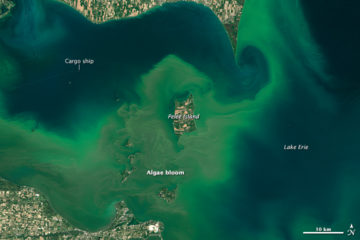
NASA satellite image from captures an algae bloom in Lake Erie in 2015. (earthobservatory.nasa.gov)
The extent of that algae bloom, Bullerjahn said, was moderate, but it had high levels of the toxin microcystin.
That crisis sent people in the region scrambling for water and scientists, officials and politicians scrambling for solutions.
However, “we can’t predict how toxic a bloom will be,” Bullerjahn said. There’s no correlation between how green a bloom is and how toxic it is. Earlier this year a toxic bloom occurred in the Maumee River near Defiance, forcing that city to resort to its back up reservoir for water.
As a result of the 2014 crisis, a goal was set last year to reduce phosphorus in the lake by 40 percent. “There’s growing agreement this will bring blooms to a manageable level,” Bullerjahn said. He said scientists are optimistic the goal can be reached.
Certainly there will be some hardship, he said, “but nobody’s going crazy.” It will take time.
“Don’t expect this to be reached soon,” McKay said.
Support Independent News In Bowling GreenMcKay said a first step is to identify “hot spots” where a large amount of phosphorus is being released.
In those areas farmers can apply the fertilizer underneath the surface of the field mitigating the run off.
Also, a return to the old practice of planting winter cover crops such as rye would help since those crops would absorb more of the nutrients in the soil.
Also, farmers can leave more buffer areas between fields and streams and the river, he said.
Bullerjahn said he would hope incentives to help farmers take these steps could be offered.
Many farmers are being proactive, he said.
Bullerjahn said fertilizer use has already declined. Probably, McKay noted, because of price.
These measures should be enough, though, to eventually achieve the 40 percent reduction, McKay said.
Other sources of phosphorus, such as sewage have already been addressed. “If you completely eliminated sewage overflow, you’d get a 5-percent reduction in phosphorus,’ Bullerjahn aid.
Also, McKay said, some people point a finger at the Detroit River as a major source of phosphorus. Indeed 2 million of the 11 million metric tons of phosphorus going into Lake Erie enters from the Detroit River. That’s balanced out by the 2 million metric tons leaving by way of the Niagara River.
Scientists are continually refining the way they look at the problem. One issue this year, Bullerjahn said, is whether there’s phosphorus left in the system from last year’s extensive bloom that may feed a bloom this year.
In 2011, Bullerjahn noted, there was a “monster” bloom, followed in 2012 by a dry year. There was no evidence of residual phosphorus causing blooms that year.
Scientists they said, are trying to differentiate between dissolved phosphorus in the system, and the phosphorus in sediment that’s less available to organisms.
McKay said the problem is the system is always evolving. Phosphorus in the river sediment may be dissolved by the time it reaches the lake.
A related issue is dead zones in the lake. These are areas where because of differences in temperature between the warmer, surface water and the colder, deeper water, there is a lack of oxygen needed for the process of decomposition of the organic matter on the lake bottom. This harms the insects and the fish that feed on them. The organic sediment then draws on other organisms in order to decompose, and that can remobilize the phosphorus in those organisms.
These dead zones, McKay said, are expected to get worse as the global temperature rises.

